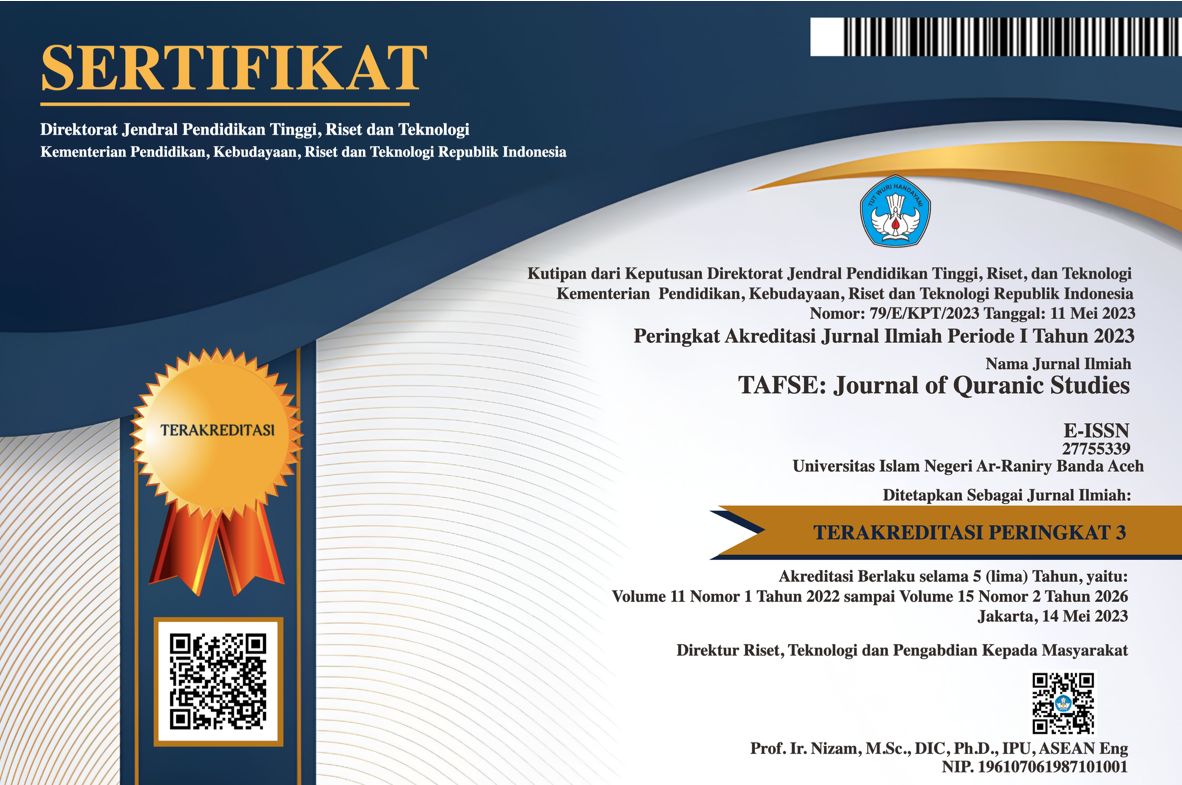Exploring Qur’anic Coherence Through Salwa El-Awa’s Pragmatic Framework
DOI:
https://doi.org/10.22373/tafse.v9i2.23622Keywords:
Qur’an, pragmatics, coherence, relevance, Salwa El-AwaAbstract
This study examines Salwa El-Awa's pragmatic approach to the structural and thematic coherence of the Qur’an, as outlined in her work Textual Relations in the Qur’an: Relevance, Coherence, and Structure. Employing a qualitative and descriptive-analytical methodology, this research explores the theories of coherence and relevance to understand the role of paragraph markers in establishing thematic and structural relationships between verses. The analysis focuses on two chapters, Surah al-Ahzab and Surah al-Qiyamah, to identify how these markers delineate paragraph boundaries and ensure the relevance of verses to the overarching message. The findings reveal that Salwa El-Awa's approach surpasses classical methods such as munasabah, which are limited to linear connections between verses, and addresses the shortcomings of modern approaches that often overlook the thematic relevance of textual components. Paragraph markers identified by Salwa elucidate structural relationships within the chapters, even when verses appear thematically unrelated. Furthermore, this study underscores the importance of integrating the internal textual context of the Qur’an with historical, social, and cultural dimensions to enhance interpretive depth.
Downloads
References
Ahmadiy, Ahmadiy. “ILMU MUNASABAH AL-QUR’AN.” Manarul Qur’an: Jurnal Ilmiah Studi Islam 18, no. 1 (July 1, 2018): 77–90. https://doi.org/10.32699/mq.v18i1.932.
Aini, Adrika Fithrotul. “Kesatuan Surat Al-Qur’an Dalam Pandangan Salwa M.S. El-Awwa.” Syahadah III No. 1 (January 1, 2015): 67–87.
Aziz, Qusyaeri, Andi Fatihul Faiz Aripai, and Nur Laili Nabilah Nazahah Najiyah. “PENAFSIRAN AL-QUR`AN BERBASIS SURAH: MELACAK KONSEP NIẒĀM AL-QUR`AN HAMID AL-DIN AL-FARAHI.” Al-Bayan: Jurnal Studi Ilmu Al- Qur’an Dan Tafsir 8, no. 2 (June 12, 2024). https://doi.org/10.15575/al-bayan.v8i2.30221.
Cazden, Courtney B. “Dell Hymes’s Construct of ‘Communicative Competence.’” Anthropology & Education Quarterly 42, no. 4 (December 31, 2011): 364–69. http://www.jstor.org/stable/41410139.
Cuypers, M. The Composition of the Qur’an: Rhetorical Analysis. Bloomsbury Publishing, 2015.
Darrow, William Ronald. “RECENT TRENDS IN HISTORICAL AND LITERARY STUDY OF THE QUR’ÂN.” MIQOT: Jurnal Ilmu-Ilmu Keislaman 35, no. 1 (June 2, 2011). https://doi.org/10.30821/miqot.v35i1.128.
El-Awa, Salwa M.S. Textual Relations in the Qur’an. Textual Relations in the Qur’ān: Relevance, Coherence and Structure. Routledge, 2006. https://doi.org/10.4324/9780203014486.
Finkbeiner, Rita, Jörg Meibauer, and Petra B. Schumacher, eds. What Is a Context? Vol. 196. Linguistik Aktuell/Linguistics Today. Amsterdam: John Benjamins Publishing Company, 2012. https://doi.org/10.1075/la.196.
Hawwa, Said. Al Asas Fi Al Tafsir. Dar al Salam, 1993.
Ibn Katsir, Abu al-Fida’ Ismail Ibn Umar. Tafsir Alquran Al-’Adzim. Riyadh: Dar Thoyibah li an-Nasyr wa at-Tauzi’, 1977.
Indrawati. “Context in Pragmatics.” Language Circle: Journal of Language and Literature 3 (2009). https://api.semanticscholar.org/CorpusID:142400426.
Iṣlāḥī, Amīn Aḥsan. Tadabbur-e-Qur’ān : Pondering over the Qur’ān. Islamic Book Trust, 2007.
Mir, Mustansir. Coherence in the Qur’an. The Other Press, 2011.
Muhamad Syaari Ab Rahman, and Wan Nasyrudin Wan Abdullah. “Perkembangan Ilmu Munasabah Dan Sumbangannya Pada Konsep Kesatuan Tema Al-Qur’an,” 2018. http://spaj.ukm.my/jalturath/index.php/jalturath/issue/view/8.
Mulazamah, Siti. “Konsep Kesatuan Tema Al-Qur’an Menurut Sayyid Qutb.” JOURNAL OF QUR’AN AND HADITH STUDIES 3, no. 2 (December 20, 2014): 203–34. https://doi.org/10.15408/quhas.v3i2.1156.
Qudsia, Miatul. “Mufasir Kontemporer Asal India: Hamiduddin Farahi.” Tafsiralquran.id, 2021. https://tafsiralquran.id/mufasir-kontemporer-asal-india-hamiduddin-farahi/.
Quṭb, Sayyid. Fī Ẓilāl Al-Qur’ān. 6th ed. Kairo: Dar as-Syuruq, 1968.
Robinson, Neal. “The Qur’an As The Word Of God.” In Heaven and Earth; Essex Essays In Theology and Ethics. Worthington, 1986.
Saleem, Shehzad, and Amin Ahsan Islahi. “Tadabbur-e-Qur’an: Pondering Over the Qur’an, Volume One; Tafsir of Surah Al-Fatihah and Surah Al-Baqarah.” Islamic Studies 48, no. 1 (2009): 119–I. https://www.proquest.com/scholarly-journals/tadabbur-e-quran-pondering-over-volume-one-tafsir/docview/288342028/se-2?accountid=33993.
Saputro, M. Endy. “Alternatif Tren Studi Qur’an Di Indonesia.” Al-Tahrir: Jurnal Pemikiran Islam 11, no. 1 (May 1, 2011): 1. https://doi.org/10.21154/al-tahrir.v11i1.24.
Sinai, Nicolai. “Historical Criticism and Recent Trends in Western Scholarship on the Quran: Some Hermeneutic Reflections.” مجلة كلية الشريعة و الدراسات الإسلامية 38, no. 1 (July 2020): 136–46. https://doi.org/10.29117/jcsis.2020.0259.
Downloads
Published
Issue
Section
License
Authors who publish with this journal agree to the following terms:
- Authors retain copyright and grant the journal right of first publication with the work simultaneously licensed under a Creative Commons Attribution License (CC BY NC 4.0) that allows others to share the work with an acknowledgment of the work's authorship and initial publication in this journal.
- Authors are able to enter into separate, additional contractual arrangements for the non-exclusive distribution of the journal's published version of the work (e.g., post it to an institutional repository or publish it in a book), with an acknowledgment of its initial publication in this journal.
- Authors are permitted and encouraged to post their work online (e.g., in institutional repositories or on their website) prior to and during the submission process, as it can lead to productive exchanges, as well as earlier and greater citation of published work (See The Effect of Open Access).





